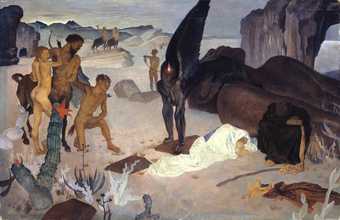
Glyn Warren Philpot
Repose on the Flight into Egypt (1922)
Tate
The exhibition commemorating the late Glyn Philpot’s contribution to British painting covers the period of his working years as an artist.
He was born in 1884, and from his early days showed a disposition for graphic art. At the age of 15 he became a pupil at the Lambeth School of Art and, thereafter, he studied at Rouen.
In France, in spite of every incitement to depart from traditional ideas of portrait painting, he was little affected by the influence dominant at the time.
Visits to Italy, and above all to Spain, while developing his dexterity and bringing him under the influence of Goya, tended only to confirm him in the conventions he had adopted to express his contacts with the visible world.
In 1902 he held his first exhibition of works in London, and in the same year exhibited his first picture (a church interior at Rouen) at the Royal Academy.
His interest in church decoration was prompted as much by his spiritual affinities as by the aesthetic appeal which the ecclesiastical subjects made to his sensibility as an artist. A religious motive not infrequently played a part in his work and when he was 22 years of age led to his being received into the Roman Catholic Church.
In 1915 he became an associate, and in 1923 a full member of the Royal Academy. In 1930 he held an exhibition of his work in Venice. This proved a turning point in his relation to art and the beginning of a revolutionary change in his outlook and method.
He determined to abandon painting altogether for the time being and seek expression for himself, his ideas and his vision in sculpture. Taking a studio in Paris, he turned his energies to modelling in clay. This phase lasted little more than a year.
In 1932 he held an exhibition of paintings in London. His art and undergone a spectacular change.
The mental and emotional process begun in Venice had ended in the renouncement of his early method and the adoption of a contemporary idiom.
Philpot's own explanation of the change is fortunately preserved in an account which he wrote for the Apollo in 1933.
In my own case the change has been towards a simplification of technique, a sacrifice of expected qualities of surface in order to obtain more rapidity and flexibility of handling and a greater force of accent. With this has gone a simplification of form, dispensing with exactitudes of drawing to obtain greater emotional weight in line. Add to this a disregard for logical chiaroscuro, when this was found to hamper the sharper detachment of one plane from another, and this is all.
All these are technical changes and all have been adopted instinctively in the search for new forms of beauty.
